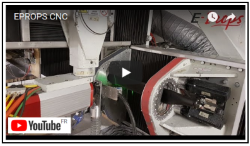E-PROPS : Fabrication
Les hélices E-PROPS sont intégralement fabriquées en France (Sud-Est, Provence, près de Sisteron).
L'équipe de 52 ingénieurs et techniciens aéronautiques produit plus de 45.000 pales en carbone par an.
Les ateliers ultra-modernes sont équipés de 12 centres d'usinage à commandes numériques.
Les pièces E-PROPS sont conçues et fabriquées pour être à la fois très légères et très solides.
Les matériaux et le procédé de fabrication sont validés par de nombreux tests et suivent un système qualité strict.

Ci-après le détail de la fabrication des pièces E-PROPS :
1- PROCEDE DE FABRICATION E-PROPS : RTM
2- PALES
3- PIEDS DE PALES
4- CONES
Toutes les pièces E-PROPS, pales, moyeux et cônes, sont fabriquées selon le procédé appelé RTM (Resin Transfer Molding).
Ce procédé est employé par de grands groupes aéronautiques comme AIRBUS et BOEING pour la fabrication de pièces carbone ultra-légères essentielles sur avions de ligne.
RTM est une des meilleures méthodes pour la production en série de pièces composites.
Ce procédé est principalement utilisé pour mouler des composants de grandes surfaces, ayant des formes complexes et nécessitant des finitions lisses.
Il y a de nombreux avantages à utiliser le procédé Resin Transfer Molding par rapport à d'autres procédés. En particulier :
- Excellente qualité de surface
- Très haut taux de fibres
- Vaste gamme de renforts possibles
- Formes complexes larges ou longues
- Faible impact environnemental
- Economie de main d'oeuvre
- Pas de contact direct avec les matériaux, procédé bien meilleur pour la santé des opérateurs
Le procédé RTM est réalisé en suivant un cycle de température. La cuisson des pièces carbone permet d'améliorer certaines propriétés, par exemple de tenue mécanique sous très hautes conditions.
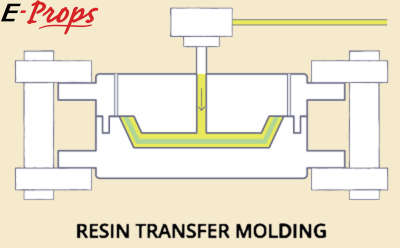
Pour garantir un contrôle qualité strict et la reproductibilité de la production, les composants sont pesés tout au long du cycle de production. Par exemple, 15 pesées sont nécessaires pour contrôler la fabrication des pièces d'une hélice E-PROPS.
E-PROPS utilise la méthode KANBAN pour piloter ses ateliers et le RFID pour le suivi des composants et des pièces de ses hélices. L’identification RFID est effectuée par le biais de puces électroniques, que l’on retrouve sur la ligne de production, dans les pales, les moyeux et tous les accessoires. Une quinzaine de lecteurs sur la ligne de production permet de mettre à jour le contenu de chaque puce RFID par un simple passage devant le détecteur.
Couplé à la méthode de gestion de pilotage des ateliers par KANBAN, le suivi de production global par RFID sécurise les étapes de fabrication, évite tout arrêt de production, maintient la qualité de la production et permet de faire à des contraintes strictes de traçabilité, évidentes quand on fabrique des produits aéronautiques high-tech. Ces méthodes et moyens optimisent la qualité de la fabrication, sécurisent et fluidifient les approvisionnements, permettent le suivi temps réel du process de production, la traçabilité de toutes les étapes de la fabrication, et offrent un ensemble d’indicateurs performants et fiables.

Un centre d’usinage 8-axes avec scanner laser permet l’analyse dimensionnelle, la rectification et la finition des composants carbone de façon complètement automatique, sans démontage de la pièce. Elle est équipée d’une broche orientable sur 8-axes programmée en fonction de la définition numérique de la pièce, avec un large magasin d’outils. La précision de mesure par le scanner laser est de 5/100e de millimètre. Le scanner balaye la pièce, puis le programme la reconnaît à l’aide de sa base de données, et ensuite les différents outils viennent effectuer toutes les tâches de finition : ébavurage, découpe, perçage, ponçage et lustrage. Toutes les étapes entre la sortie du moule et le transfert au stock de pièces finies sont automatiques.
Les pièces carbone fabriquées grâce au procédé RTM process puis terminées à l'aide d'un centre d'usinage précis, comme les hélices E-PROPS, sont bien supérieures aux pièces en fibres de verre conventionnelles (procédé dit "demi-coquilles"), en termes de propriétés structurelles, de qualité, de légèreté et d'esthétique.
Toutes les pales E-PROPS sont fabriquées en TRESSE CARBONE + RESINE EPOXY.
- TRESSE CARBONE, procédé HCF.
Le carbone présente un excellent compromis rigidité/poids.
L'utilisation d'un seul matériau (le carbone) est bien meilleur que l'utilisation de deux matériaux, comme par exemple un mélange de fibre de verre et de carbone (souvent utilisé pour économiser le carbone qui est beaucoup plus cher que la fibre de verre). Les hélices comportant un seul matériau de base possèdent un potentiel (durée d'utilisation préconisée par le fabricant) beaucoup plus élevé.
Le procédé HCF (Helical Continuous Fibers : Fibres Continues Hélicoïdales), développé spécifiquement par E-PROPS, assure une résistance exceptionnelle de la pale 100% carbone + résine époxy, du bord d'attaque au bord de fuite, du pied de pale au saumon. Contrairement au process traditionnel dit "demi-coquille", les fibres sont continues entre l'intrados et l'extrados. La tresse de carbone est fabriquée comme une chaussette. La résistance mécanique de l'ensemble est accrue : pas le moindre risque d'explosion de la pale par délaminage de bord d'attaque, pas de criques sur la pale ou le moyeu.
Pour fabriquer de très solides pièces en carbone, le plus important est d'avoir le maximum de fibres et le minimum de résine, c'est-à-dire un très haut taux de fibres.
Les fibres de carbone sont 50 fois plus résistantes que la résine.
Valeurs de résistance à la traction :
- fibres de carbone : 4.000 MPa
- résine époxy : 80 MPa
Les pièces fabriquées par E-PROPS ont un taux de fibres de carbone extrêmement élevé : 63% (ce qui est exceptionnel).
Par exemple, une pale en deux demi coquilles collées a un taux de fibres de verre d'environ 30%. L'écart est très important, non seulement en ratio, mais également parce que les fibres de carbone sont bien plus résistantes que les fibres de verre :
- fibres de verre : 2.600 MPa
- fibres de carbone : 4.000 MPa
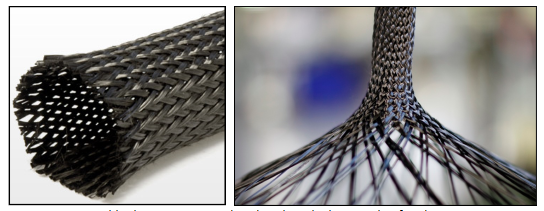
La RESINE EPOXY est la meilleure résine pour l'aéronautique parce qu’elle possède :
* de très bonnes propriétés mécaniques et thermiques
* une très grande résistance à la fatigue
* une bonne stabilité dimensionnelle
* une bonne performance chimique
* et surtout, une excellente adhésion aux fibres de carbone
La résine époxy utilisée par E-PROPS possède un additif pour résister aux UV (UVA et UVB).
Détails de fabrication des pales :
- Coeur en mousse technique, avec un longeron interne (D-Box)
- Gamme ULM / LSA : pied de pale avec un tor en titane à l'intérieur
- 100% carbone, sans aucune pièce métallique = pas de corrosion galvanique
- Blindage interne de bord d'attaque : injection d'une résine spéciale avec additif choc Nanostrength® => Voir la page PROTECTION DE BORD D'ATTAQUE
- N° de référence unique pour chaque pale pour une traçabilité parfaite (puce RFID à l'intérieur)
- Les jeux de pales sont équilibrés ensemble, avec une tolérance de moment statique strict => Voir page EQUILIBRAGE
- Les pales sont polishées pour une finition parfaite. Pas de peinture, pas de vernis, pas de gel-coat. => Voir page RESPONSABILITE ENVIRONNEMENTALE

Longeron interne dans la pale / pied de pale (très simple, sans pièce métallique)
Gamme à pas fixe :
Fabriqué 100% en tresse de carbone, dans la suite de la pale, renforcé au pied par plusiseurs couches de tresse.
Deux parties sectionnables, très simple à assembler.
Epaisseur du pied de pale : 38 mm
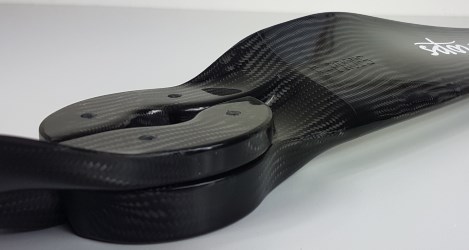
Les cônes E-PROPS sont fabriqués en TISSU de CARBONE + RESINE EPOXY.
The procédé RTM est utilisé pour les cônes.
Ces cônes sont très légers. La platine est fixée au milieu du cône : ce renfort central rend le cône plus solide.
Détails de fabrication des cônes :
- 100% en tissu de carbone
- N° de référence unique pour chaque cône et platine pour une traçabilité parfaite (puce RFID à l'intérieur)
- Les cônes et leurs platines sont équilibrés ensemble. Si nécessaire, une vis est fixée dans la platine pour un équilibrage parfait. Cette vis ne doit pas être enlevée.
- Les cônes sont polishés pour une finition parfaite. Pas de peinture, pas de vernis. => Voir page RESPONSABILITE ENVIRONNEMENTALE. Le client peut peindre son cône s'il le souhaite.
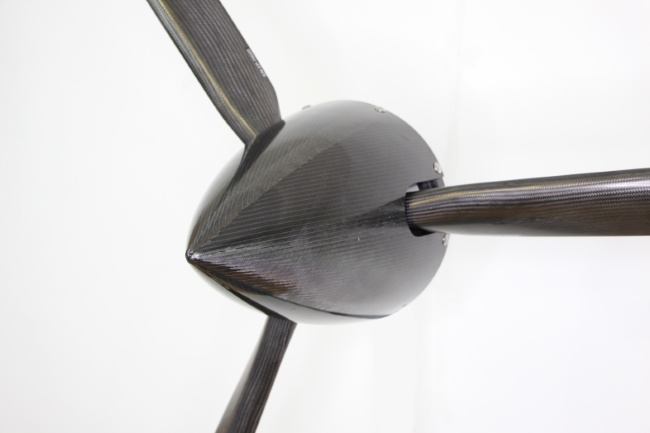
15 diamètres de cônes : de 210 à 380 mm
L'équipe de 52 ingénieurs et techniciens aéronautiques produit plus de 45.000 pales en carbone par an.
Les ateliers ultra-modernes sont équipés de 12 centres d'usinage à commandes numériques.
Les pièces E-PROPS sont conçues et fabriquées pour être à la fois très légères et très solides.
Les matériaux et le procédé de fabrication sont validés par de nombreux tests et suivent un système qualité strict.

Ci-après le détail de la fabrication des pièces E-PROPS :
1- PROCEDE DE FABRICATION E-PROPS : RTM
2- PALES
3- PIEDS DE PALES
4- CONES
1- PROCEDE DE FABRICATION E-PROPS : RTM
Toutes les pièces E-PROPS, pales, moyeux et cônes, sont fabriquées selon le procédé appelé RTM (Resin Transfer Molding).
Ce procédé est employé par de grands groupes aéronautiques comme AIRBUS et BOEING pour la fabrication de pièces carbone ultra-légères essentielles sur avions de ligne.
RTM est une des meilleures méthodes pour la production en série de pièces composites.
Ce procédé est principalement utilisé pour mouler des composants de grandes surfaces, ayant des formes complexes et nécessitant des finitions lisses.
Il y a de nombreux avantages à utiliser le procédé Resin Transfer Molding par rapport à d'autres procédés. En particulier :
- Excellente qualité de surface
- Très haut taux de fibres
- Vaste gamme de renforts possibles
- Formes complexes larges ou longues
- Faible impact environnemental
- Economie de main d'oeuvre
- Pas de contact direct avec les matériaux, procédé bien meilleur pour la santé des opérateurs
Le procédé RTM est réalisé en suivant un cycle de température. La cuisson des pièces carbone permet d'améliorer certaines propriétés, par exemple de tenue mécanique sous très hautes conditions.

Pour garantir un contrôle qualité strict et la reproductibilité de la production, les composants sont pesés tout au long du cycle de production. Par exemple, 15 pesées sont nécessaires pour contrôler la fabrication des pièces d'une hélice E-PROPS.
E-PROPS utilise la méthode KANBAN pour piloter ses ateliers et le RFID pour le suivi des composants et des pièces de ses hélices. L’identification RFID est effectuée par le biais de puces électroniques, que l’on retrouve sur la ligne de production, dans les pales, les moyeux et tous les accessoires. Une quinzaine de lecteurs sur la ligne de production permet de mettre à jour le contenu de chaque puce RFID par un simple passage devant le détecteur.
Couplé à la méthode de gestion de pilotage des ateliers par KANBAN, le suivi de production global par RFID sécurise les étapes de fabrication, évite tout arrêt de production, maintient la qualité de la production et permet de faire à des contraintes strictes de traçabilité, évidentes quand on fabrique des produits aéronautiques high-tech. Ces méthodes et moyens optimisent la qualité de la fabrication, sécurisent et fluidifient les approvisionnements, permettent le suivi temps réel du process de production, la traçabilité de toutes les étapes de la fabrication, et offrent un ensemble d’indicateurs performants et fiables.

Un centre d’usinage 8-axes avec scanner laser permet l’analyse dimensionnelle, la rectification et la finition des composants carbone de façon complètement automatique, sans démontage de la pièce. Elle est équipée d’une broche orientable sur 8-axes programmée en fonction de la définition numérique de la pièce, avec un large magasin d’outils. La précision de mesure par le scanner laser est de 5/100e de millimètre. Le scanner balaye la pièce, puis le programme la reconnaît à l’aide de sa base de données, et ensuite les différents outils viennent effectuer toutes les tâches de finition : ébavurage, découpe, perçage, ponçage et lustrage. Toutes les étapes entre la sortie du moule et le transfert au stock de pièces finies sont automatiques.
Les pièces carbone fabriquées grâce au procédé RTM process puis terminées à l'aide d'un centre d'usinage précis, comme les hélices E-PROPS, sont bien supérieures aux pièces en fibres de verre conventionnelles (procédé dit "demi-coquilles"), en termes de propriétés structurelles, de qualité, de légèreté et d'esthétique.
2- PALES
Toutes les pales E-PROPS sont fabriquées en TRESSE CARBONE + RESINE EPOXY.
- TRESSE CARBONE, procédé HCF.
Le carbone présente un excellent compromis rigidité/poids.
L'utilisation d'un seul matériau (le carbone) est bien meilleur que l'utilisation de deux matériaux, comme par exemple un mélange de fibre de verre et de carbone (souvent utilisé pour économiser le carbone qui est beaucoup plus cher que la fibre de verre). Les hélices comportant un seul matériau de base possèdent un potentiel (durée d'utilisation préconisée par le fabricant) beaucoup plus élevé.
Le procédé HCF (Helical Continuous Fibers : Fibres Continues Hélicoïdales), développé spécifiquement par E-PROPS, assure une résistance exceptionnelle de la pale 100% carbone + résine époxy, du bord d'attaque au bord de fuite, du pied de pale au saumon. Contrairement au process traditionnel dit "demi-coquille", les fibres sont continues entre l'intrados et l'extrados. La tresse de carbone est fabriquée comme une chaussette. La résistance mécanique de l'ensemble est accrue : pas le moindre risque d'explosion de la pale par délaminage de bord d'attaque, pas de criques sur la pale ou le moyeu.
Pour fabriquer de très solides pièces en carbone, le plus important est d'avoir le maximum de fibres et le minimum de résine, c'est-à-dire un très haut taux de fibres.
Les fibres de carbone sont 50 fois plus résistantes que la résine.
Valeurs de résistance à la traction :
- fibres de carbone : 4.000 MPa
- résine époxy : 80 MPa
Les pièces fabriquées par E-PROPS ont un taux de fibres de carbone extrêmement élevé : 63% (ce qui est exceptionnel).
Par exemple, une pale en deux demi coquilles collées a un taux de fibres de verre d'environ 30%. L'écart est très important, non seulement en ratio, mais également parce que les fibres de carbone sont bien plus résistantes que les fibres de verre :
- fibres de verre : 2.600 MPa
- fibres de carbone : 4.000 MPa

La RESINE EPOXY est la meilleure résine pour l'aéronautique parce qu’elle possède :
* de très bonnes propriétés mécaniques et thermiques
* une très grande résistance à la fatigue
* une bonne stabilité dimensionnelle
* une bonne performance chimique
* et surtout, une excellente adhésion aux fibres de carbone
La résine époxy utilisée par E-PROPS possède un additif pour résister aux UV (UVA et UVB).
Détails de fabrication des pales :
- Coeur en mousse technique, avec un longeron interne (D-Box)
- Gamme ULM / LSA : pied de pale avec un tor en titane à l'intérieur
- 100% carbone, sans aucune pièce métallique = pas de corrosion galvanique
- Blindage interne de bord d'attaque : injection d'une résine spéciale avec additif choc Nanostrength® => Voir la page PROTECTION DE BORD D'ATTAQUE
- N° de référence unique pour chaque pale pour une traçabilité parfaite (puce RFID à l'intérieur)
- Les jeux de pales sont équilibrés ensemble, avec une tolérance de moment statique strict => Voir page EQUILIBRAGE
- Les pales sont polishées pour une finition parfaite. Pas de peinture, pas de vernis, pas de gel-coat. => Voir page RESPONSABILITE ENVIRONNEMENTALE

Longeron interne dans la pale / pied de pale (très simple, sans pièce métallique)
3- PIEDS DE PALES
Gamme à pas fixe :
Fabriqué 100% en tresse de carbone, dans la suite de la pale, renforcé au pied par plusiseurs couches de tresse.
Deux parties sectionnables, très simple à assembler.
Epaisseur du pied de pale : 38 mm

4- CONES
Les cônes E-PROPS sont fabriqués en TISSU de CARBONE + RESINE EPOXY.
The procédé RTM est utilisé pour les cônes.
Ces cônes sont très légers. La platine est fixée au milieu du cône : ce renfort central rend le cône plus solide.
Détails de fabrication des cônes :
- 100% en tissu de carbone
- N° de référence unique pour chaque cône et platine pour une traçabilité parfaite (puce RFID à l'intérieur)
- Les cônes et leurs platines sont équilibrés ensemble. Si nécessaire, une vis est fixée dans la platine pour un équilibrage parfait. Cette vis ne doit pas être enlevée.
- Les cônes sont polishés pour une finition parfaite. Pas de peinture, pas de vernis. => Voir page RESPONSABILITE ENVIRONNEMENTALE. Le client peut peindre son cône s'il le souhaite.

15 diamètres de cônes : de 210 à 380 mm

